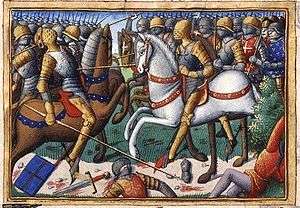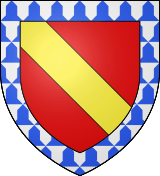Gilbert Motier de La Fayette
| Gilbert Motier de La Fayette | |
|---|---|
 | |
| Other name(s) | Gilbert III de Lafayette |
| Born |
1380 Auvergne |
| Died |
February 22, 1462 (aged 81) Auvergne |
| Buried at | Abbey of La Chaise-Dieu (45°19′20″N 3°41′51″E / 45.32222°N 3.69750°E) |
| Allegiance | Kingdom of France |
| Years of service | 1409-1449 |
| Rank | Marshal of France |
| Battles/wars | |
| Spouse(s) |
|
Gilbert Motier de La Fayette (1380 – 22 February 1462) seigneur of La Fayette, Pontgibaud, Ayes, Nébouzac, Saint-Romain and Montel de Gelat was a Marshal of France and an ancestor of Gilbert du Motier, Marquis de Lafayette.
Biography
Gilbert Motier de La Fayette was brought up at the court of Louis II, Duke of Bourbon. He served under Marshal Boucicaut in Italy and on his return to France after the evacuation of Genoa in 1409 became seneschal of the Bourbonnais.[1]
He was the comrade of Joan of Arc. In the English wars he was with John I, Duke of Bourbon, at the capture of Soubise in 1413 and of Compiègne in 1415. The duke then made him lieutenant-general in Languedoc and Guienne. He failed to defend Caen and Falaise, for the dauphin (afterwards Charles VII.) against Henry V of England in 1417 and 1418, but in the latter year he held Lyons for some time against Jean, duke of Burgundy. A series of successes over the English and Burgundians on the Loire was rewarded in 1420 with the governor of Dauphiné and the office of marshal of France. He was chamberlain of the king, bailli of Rouen (1417), and Seneschal of Beaucaire and Nîmes.

He and John Stewart, Earl of Buchan commanded the Franco-Scottish troops at the Battle of Baugé in 1422, though he did not, as has been sometimes stated, slay Thomas, duke of Clarence, with his own hand. In 1424, he was taken prisoner by the English at the battle of Verneuil, but was released shortly afterwards, and fought with Joan of Arc in relief of the siege of Orléans leading 300 men at arms, and at the battle of Patay in 1429. He attended the coronation of Charles VII in Reims on 17 July 1429. He strengthened the defenses and enlarged the keep of Château-Dauphin in Pontgibaud.
The marshal had become a member of the Grand Conseil of Charles VII, and with the exception of a short disgrace about 1430, due to the ill-will of Georges de la Trémoille, he retained the royal favour all his life. He took an active part in the army reform initiated by Charles VII from 1445 to 1448, and the establishment of military posts for the suppression of brigandage. He is among the negotiators and signatories to the Treaty of Arras, in 1435 and the treaty with the Duke of Somerset, in 1449. His last campaign was against the English in Normandy in 1449. He received the surrender of the city of Rouen October 19, 1449.
He died on 23 February 1462. He was buried in the Abbey of La Chaise-Dieu.
Motto and Coat of Arms
| Coat of Arms | Motto |
 |
|
On his headstone, in the abbey of La Chaise-Dieu, one can read the motto "Merito". In the true to the spirit of the Middle Ages, he chose an anagram of his name, Motier.
Family
He was the son of William Motier La Fayette (seigneur of La Fayette, knight and man at arms of John, Duke of Berry) and Marguerite Catherine Brun du Peschin, dame de Pontgibaud. He had a brother:
and two sisters, both of whom are ancestors of Gilbert du Motier, Marquis de Lafayette:
- Algaye, wife of Bérnaud du Lac, seigneur du Montel.
- Gilberte, wife of Jean de Vassel, seigneur de Vassel a knight.
He first married Dauphine de Monteith (1400-1423) in 1420. He later, on January 15, 1423, wed Jeanne de Joyeuse (1405-1466), daughter of Lord Randon de Joyeuse and Catherine Aubert, Lady Monteil Gelat. He had nine children by his second marriage, including:
- Charles, seigneur of La Fayette. (1425–1486), knighted at the siege of Rouen in 1449, commanded fifty lances in 1466, attended the Estates General in 1468, adviser and chamberlain of the king before 1480;
- Antoine, seigneur of Bothéon Veauche and Goutenourouze (1426–1480) counselor and chamberlain of King Louis XI, Captain of Roque-Servieres in 1470 and of Nonette in 1486;
- Gilbert IV, lord of Saint-Romain (1440–1527) esquire to kings Louis XI and Charles VIII, from 1474 to 1486, maître d'hotel of Charles VIII in 1490, married Isabeau de Polignac, father of:
- Antoine (1474-1531) seigneur of Pontgibaud, Montel de Gelat, of Rochedagoux, knight, governor of Boulogne, seneschal of l'on-thieu and Grand Master of Artillery before 1515.
.jpg)
- Anne (1475-1524) wife of Louis Lastic, ancestor of Gilbert du Motier, Marquis de Lafayette.
- Louis (1431-?) canon-count of Lyon
- Jean(1330-1490) Knight of St. John
- Catherine (c.1432-1484) married Hughes de Chauvigny Baron de Blot (1410-1468). Their son, Raynard de Chauvigny de Blot (?-1491), was Abbot of La Chaise-Dieu 1465-1491 whose great uncle Hughes de Chauivgny de Blot, the privious abbot (1420-1465), retired in his favor.
- Anne (1434-?) marred François de Maubec Seigneur de Maubec and de Montlear.
- Jeane (1435-?)
- Françoise (1427-?) married Jacques Fourrier.
The Marshal La Fayette also had a natural daughter
- Louise ( -1456) married Jehan de La Roche in 1419 and he inherited Château de Tournoël subject to an usufruct. Jehan was killed during the Battle of Verneuil in August 1424 at age 22. They had three children. When his father, Nicolas, died in 1428, Jehan's brothers claimed Château de Tournoël from the his widow. Château de Tournoël was sequestered by the Senechal until a judicial settlement. In 1429, Château de Tournoël was given to the widow Louise de La Fayette and her children. She was an ancestor of Gilbert du Motier, Marquis de Lafayette.
References
External links
 This article incorporates text from a publication now in the public domain: Chisholm, Hugh, ed. (1911). "La Fayette, Gilbert Motier de". Encyclopædia Britannica (11th ed.). Cambridge University Press.
This article incorporates text from a publication now in the public domain: Chisholm, Hugh, ed. (1911). "La Fayette, Gilbert Motier de". Encyclopædia Britannica (11th ed.). Cambridge University Press.